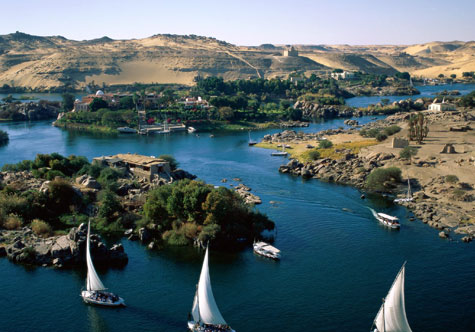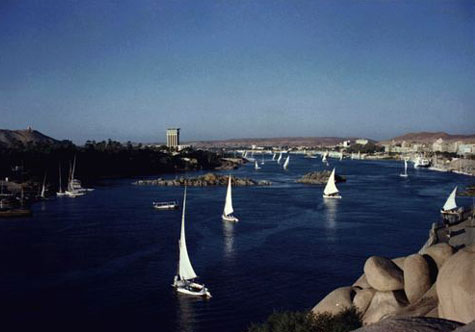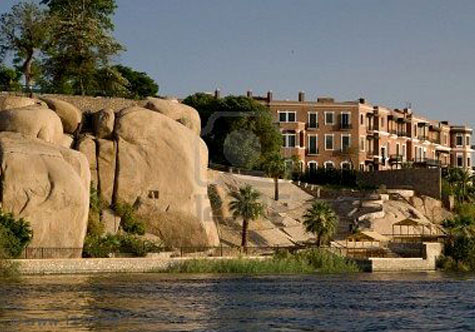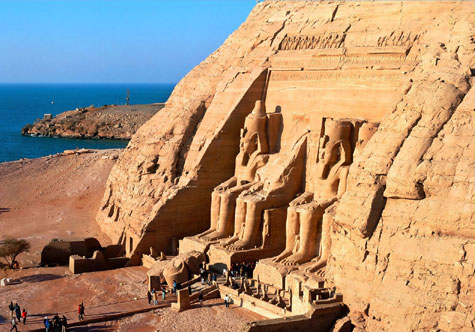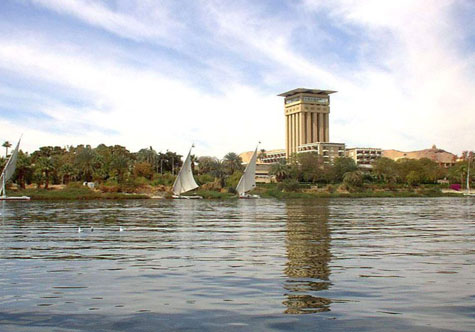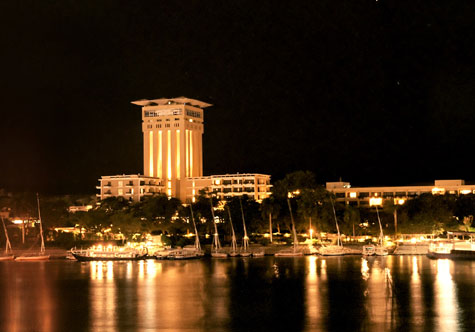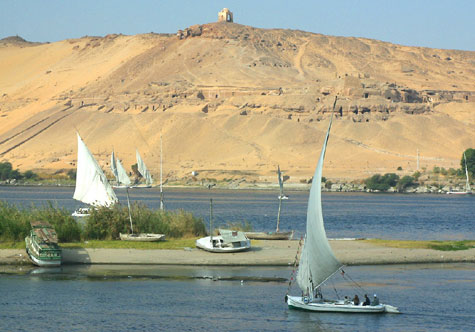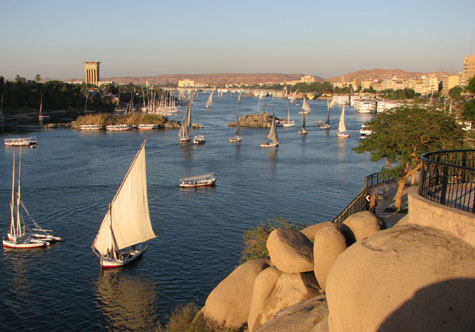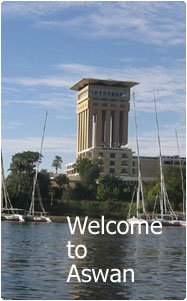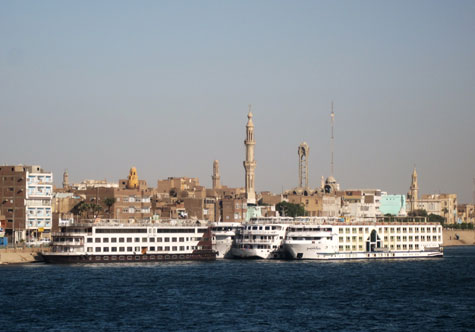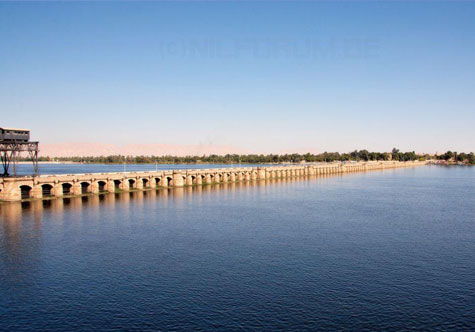Egypt Excursions » Aswan
AswanASWAN
ASWAN ISLAND & THE AGHA KHAN
This is one of romantic excursions which you can have in Egypt. A typical felucca will carry our visitors to see legendary Elephantine Island where it is built the 3rd dynasty temple of Khnum about 2800 BC. Elephantine is Aswan's largest island. It used to have an important role back since the Old Kingdom. Being a capital of the province, the island became a big trade center. Pharaohs built temples and made the island center of the cult of Khnum, the god-creator. And even during the Persian era, Jews built their own temple in the island that was later destroyed by pagan priests. The island is said to gain its name from the shape of its bulbous rocks that resemble elephants. The island is also believed to have had elephants or it was a center of ivory trading. It is big enough to include many activities. There are three inhabited Nubian villages, a museum, a modern hotel and several monuments in Elephantine. The island, which is about 2 kilometers (1.2 miles) long, is also known as Aswan Island. Than they will see Agha Khan Tomb located on the west bank of Aswan Island. These tombs are famous not only because of Agha Khan and his family, but also for the panoramic view that showing the beauty of Aswan city and colors contrast of the river Nile valley and the desert.
DAM & THE UNFINISHED OBELISK
Take a private tour to explore three of Aswan most popular and well known sites. Walk on the High Dam which separates Lake Nasser (one of the most enormous artificial lakes all over the world, with about 5250 square km) from the Nile, be astounded at the size of the Unfinished Obelisk, and enjoy the beauty of Philae Temple's island location. First customers will see the famous High Dam of Aswan, an engineering miracle, built in the 1960s, 17times bigger and containing more material than it was used in the Great Pyramid of Cheops or the other dam built in the end of the 19th century. On the way back they will see one of Aswan granite stone queries in which lies The Unfinished Obelisk, examining the ancient Egyptian technique in cutting an obelisk of about 1168 tons and carrying it to Thebes, more than 200 kilometers to the north.
DAM & OBELISK & PHILAE TEMPLE
One of the picturesque places in Egypt is Philae temple. This great Isis temple is called The Gem of Egypt. Customers will be transported by motor-boat on the Agelika Island, where nowadays an interesting Greek-roman complex is placed. Our guide will show the visitors how these temples had been rescued from the water of Nile by the help of UNESCO.
This half day trip will also include visit of High Dam and The Unfinished Obelisk.
PHILAE SOUND & LIGHT SHOW
Have you ever wondered what life have been thousands years ago? You will know about them through the creation of sound and light shows. Fabulous romantic motor-boat ride takes about 10 minutes and will enable our clients witnessing a special show that is not to be repeated in other places all over the world – an unforgettable show.
ABU SIMBEL
Abu Simbel is located about 280 km southern of Aswan. Two temples had been built by the great pharaoh Ramses II in 1293 BC. These are the only two complete temples cut in the rock. The first one weights about 36.500 tons, the second one about 55.000 tons. Both had been salvaged from Nile waters that threatened these great temples after the building of the high dam of Aswan. The visit will take 25 minutes by plane from Aswan to Abu Simbel. The visit of Abu Simbel temples needs about two hours.
KOM OMBO
A one hour visit of Kom Ombo will show to our clients its marvelous temple dated in the 2nd century BC, dedicated to Sobek, the crocodile headed god. Even Kom Ombo city is far from the ruins, still some habitants offer our tourists the chance to bargain over typical cotton t-shirts and local gowns. The visit of Kom Ombo temple would be carried out on foot as the temple is about five minutes walking from the boat dock and is it possible to see it from the boat sun deck.
EDFU
Edfu is the next stop of any boat going out of Kom Ombo. Edfu is the most intact and complete temple now in Egypt. The actual construction date goes back to Greek times about 237 BC. You will be surprised how good condition is the temple in. Something you will not see in any other country all over the world. The temple is dedicated to Horus, the falcon headed god.
ESNA
Esna is located about fifty kilometers south of Luxor. The temple now stands in the middle of the modern town at a level about nine meters below that of the surrounding grounds. However, texts mentions that it was built on the site of a temple that may have been constructed as early as the reign of Tuthmosis III. Some blocks of the earlier 18th Dynasty structure are preserved. The present structure dates to the Greek and Roman periods and is one of the latest temples to have been built by the ancient Egyptians. The modern Egyptian village of Esna, which was ancient Iunyt or Ta-senet (from which the Coptic Sne and Arabic Isna derive), was built in the area of ancient Latopolis and is the site of a major temple dedicated to the god Khnum. Under the Greeks and Romans, the city became the capital of the Third Nome of Upper Egypt. Besides Khnum, the temple was dedicated to several other deities, the most prominent of whom were Neith and Heka. This was the ram god that was worshipped through out this area and who fashioned mankind from mud of the Nile on his potter's wheel.
ASWAN ISLANDS & AGHA KHAN & THE MONASTERY OF SAINT SIMON
This tour contains a camel ride near to Agha Khan and examination of Coptic architecture showed in the monastery of Saint Simon. A camel ride takes about 40 minutes to go and to get back through the sands of the Aswan desert.
The monastery was built in the 6th century and monks abandoned it later, probably after 7 centuries, because of cruel barbaric attacks. Although abandoned, it is in a good state of preservation and secluded in the deserts of Aswan. The monastery has massive walls and is built in two levels: the lower level is built of stone while the upper one of mud bricks. It has a keep that was supposed to harbor the monks at the time of attacks. The monastery looks like a fortress rather than a religious compound. Buildings inside follow the typical composition of Coptic monasteries: a church, storeroom, kitchens, bakeries and dormitories. The monastery is reached by a horse ride from the Qubbet Al-Hawa or through a route from Agha Khan Mausoleum.

